Symmetric octominoid configurations
In this page:
Other documents:
-
magic27_annotated.txt: Analysis
of the table
magic27 ordered by coordinates in the table
-
POV-Ray images of some GRAY configurations (configurations
with both vanishing invariants but not yet constructed by me with the puzzle).
Update (2015/02/01): All those configurations have subsequently been constructed,
right now there are no gray configurations.
-
Complete list of 3D octominoid configurations
of the Rubik's Magic that have both metric and topological vanishing
invariants. Listed by rubiksmagic code.
- Source code and header file of the program computing the two
invariants.
BACK
Symmetric configurations with vanishing invariants not listed in table
magic27.gif of
Jürgen Köller [Ko] (included below) and
taken from:
http://www.mathematische-basteleien.de/magics.htm:
TABLE 1
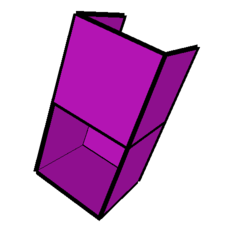
011-013-101-110-112-123-211-213s
| 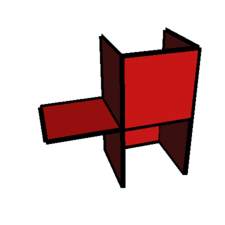
011-013-101-112-123-211-213-312s
| 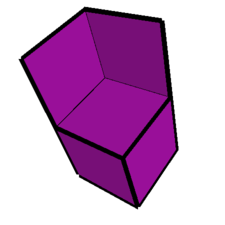
011-013-101-103-110-112-121-211s
| 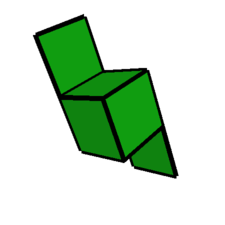
011-013-103-105-112-114-123-213s
|
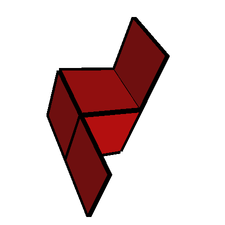
011-013-101-110-112-121-211-231s
| 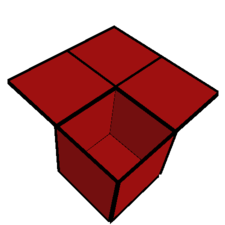
011-013-031-123-132-134-143-233s
| 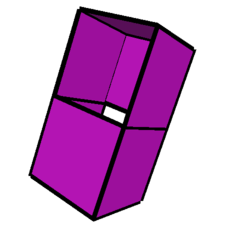
011-013-101-110-114-123-211-213s
| 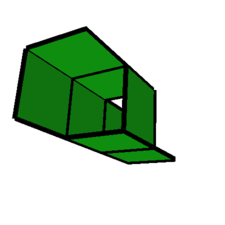
011-013-015-101-103-123-125-213s
|

112-121-123-132-211-233-312-332s
| 
112-121-123-211-213-231-323-332s
|
Copy of the table magic27.gif
TABLE 2
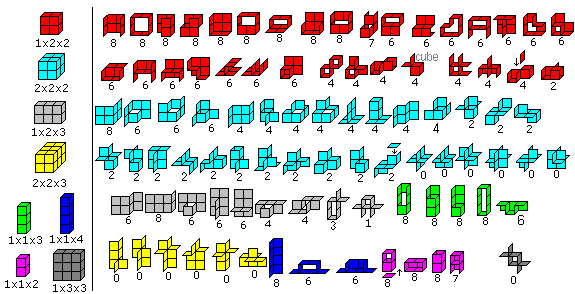
|
Snapshots of real puzzle configurations
TABLE 3
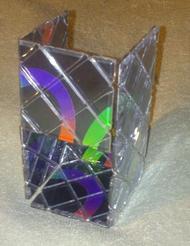
011-013-101-110-112-123-211-213s
| 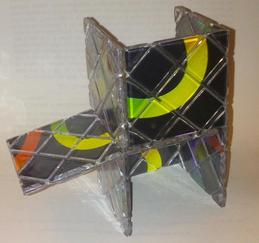
011-013-101-112-123-211-213-312s
| 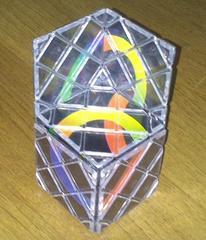
011-013-101-103-110-112-121-211s
| 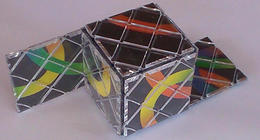
011-013-103-105-112-114-123-213s
|
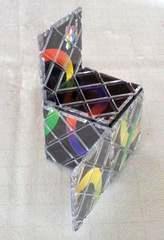
011-013-101-110-112-121-211-231s
| 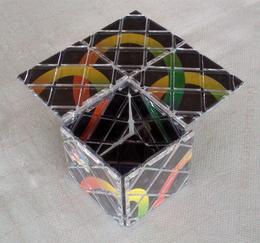
011-013-031-123-132-134-143-233s
| 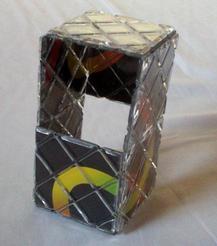
011-013-101-110-114-123-211-213s
| 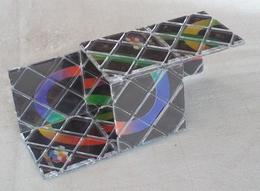
011-013-015-101-103-123-125-213s
|
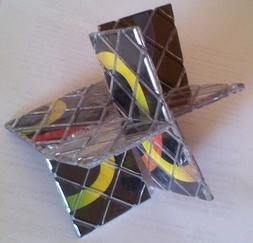
112-121-123-132-211-233-312-332s
| 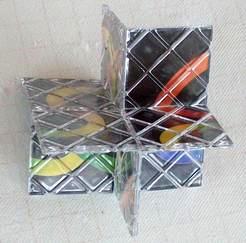
112-121-123-211-213-231-323-332s
|
Trivia and remarks
I only recently found the very interesting paper [Ver] where the
topological invariant is also introduced.
- The armchair (first picture in tables 1 and 3) was the last feasible octominoid to be
actually constructed.
-
Start from the configuration of this image
(instructions to get there can be found in [Pao])
- close both flaps (turning them 90 degrees)
- switch the hinging side of both flaps and open carefully (there is some stretching!)
- the resulting shape has a form almost identical to the cubechair (third picture in tables
1 and 3 above). It has two superposed tiles.
- turn 90 degrees one of the two superposed tiles (as a flap).
- another tile becomes a flap and can be turned down 180 degrees. We get to the cubechair shape above.
- push the same flap further inside the cube 90 degrees against the upper tile of the cube, which becomes a flap.
- Finally lift that new flap 90 degrees in the desired position.
- The cube (row 2, column 11 in table 2) can be realized by 3 distinct puzzle
configurations, two are constructible: one (RmRmUmLmLmDvDmDv) is described in
[Ko], the
other (RmRmDmLmLvRmLvUm) can be reached from configuration of row 1, column 14 in table 2.
The remaining configuration (RmRmUmLmLvRmLvDm) has both vanishing invariants, but I don't know if it is
constructible.
- The basket (row 6, column 10 in table 2) has two distinct realizations
with the puzzle, both constructible.
One is described in [Ko]
as an intermediate configuration towards the cube, the other is discussed in
[Pao].
- The two cubes with flaps above: the first green (row 1, column 4 in table 1) and the second red
(row 2, column 1 in table 1) can be constructed from the cube variant 2 (RmRmDmLmLvRmLvUm) by
flipping a tile inside the cube.
- The third red configuration above (row 2, column 2 in table 1) has two realizations, both are
constructible from the two realizations of the "basket" shape.
- The first light blue configuration of table 1 (row 3, column 1 in tables 1 and 3) can be obtained
by starting from configuration in row 2 column 7 of table 2.
Octominoid code syntax
An octominoid is described by a string of the form xyz-xyz-xyz-xyz-xyz-xyz-xyz-xyz[s].
It consists of a set of 8 squares of side 2 with vertices having even integer coordinates.
Each sequence of three integers xyz indicates the position of a square by means
of the coordinates of its center.
The only even coordinate indicates the orientation of the square.
The presence of the (optional) final 's' indicates that the given configuration
corresponds to a symmetric octominoid (with respect to any isometry of space).
Two octominoids are considered equivalent if related by an isometry of space (reflections
included), the printed configuration descriptions correspond to a canonical selection among
all equivalent octominoids, based on a suitable total ordering.
The software code can compute the canonical representative of a given configuration.
Rubik's Magic configuration code syntax
A Rubik's Magic configurations is a circular list of the eight tiles positioned in space
in such a way that consecutive tiles are connected through a common side.
Each tile can be oriented by drawing an arrow on one of its faces parallel to a side
as explained in [Pao].
A valid Rubik's Magic configuration admits a consistent orientation of the tiles
(one tile is oriented in any way, then all the others uniquely inherit their orientation).
As explained in [Pao] the tile orientation is inherited by reflecting the
arrow drawn on an adjacent tile.
In the octominoid configurations, consecutive tiles form an angle with three possible
values:
- Straight: the two tiles are coplanar
- Mountain fold: they form a 90 degrees angle of mountain type (origami
terminology) with respect to the faces with the arrow
- Valley fold: they form a 90 degrees angle of valley type
Now a configuration description consists of a sequence of eight directions
that indicate the relative position of a tile with respect to the previous one.
A direction consists of a capital letter among R, L, U,
D, standing repectively for right, left, up, down.
The capital letter is followed by m in case of a mountain fold, by
v in case of a valley fold.
For example the sequence RRRURRRU is the flat starting configuration of the
puzzle.
A sequence can be prefixed by a \ if the starting tile is of backslash
type (the type of a tile, slash or backslash, is decided once we chose its orientation and
depends on the direction of the nylon strings).
Two configurations are considered equivalent if they are the same up to choice of the
first tile of the circular list, the traversal direction of circular list and the
choice of orientation (slash and backslash tiles must be considered as distinct).
Web References
- [Ko]
- http://www.mathematische-basteleien.de/magics.htm
- [Pao]
- http://arxiv.org/abs/1401.3699
[Ver]
Tom Verhoeff (1987).
Magic
and Is Nho Magic, Cubism For Fun (15): 24-31. Retrieved 2014-08-28.




















